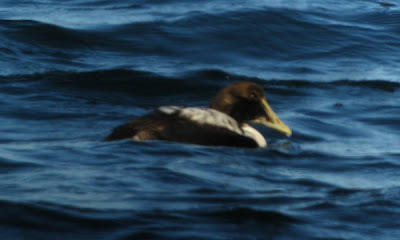Common Raven / USFWS Photo
Corvids – crows, ravens, jays, and magpies – are
well known to be among the most intelligent of birds. Along with parrots, corvids have been a frequent subject of avian intelligence studies. Experiments have documented
problem-solving and
tool use, both
in the lab and
in the wild. Many of the recent experiments have tested intelligence in New Caledonian Crows (
Corvus moneduloides), but tests of Ravens (
Corvus corax) and Rooks (
Corvus frugilegus) have also found problem-solving capabilities. New Caledonian Crows are a common subect for research because they are known to use a variety of tools in the wild.
A classic test of bird intelligence involves a piece of food dangling at the end of a string. Multiple bird species can figure out through trial and error how to retrieve the food by pulling the string.
Corvids and
psittacids retrieve the food so quickly that researchers have suggested that these birds may solve the problem at an advanced level. That is, instead of relying on trial and error, these birds might be able to picture a solution in their minds. Experiments with Ravens and Keas (
Nestor notabilis) have provided some hints of advanced problem-solving, but the birds have difficulty retrieving food at the end of a string if the string is crossed by another of the same color.
A new
PLoS ONE article takes the intelligence tests a step further with New Caledonian Crows. Once again, a piece of meat is suspended at the end of a string. This time, however, the reward is screened from view by a piece of plywood with a small hole in it – just wide enough to pull the meat through. If a crow goes under the board, it can see the food and string. From above the board, it can still see the reward through the hole, but not well enough to judge its distance or whether pulling the string is moving the meat closer. The image shows the setup for this study;
this image shows examples of prior experiments. Successful retrieval would require pulling the string part way, stepping on the portion pulled, and then pulling the rest of the string.
When this problem (A) was presented to four crows that already had some experience retrieving meat on strings, the crows were able to solve the problem, but with difficulty. The experienced crows made more mistakes and took longer to arrive at a solution. Naïve crows – ones with no experience of string problems – had a much harder time. One naïve crow was able to complete the task (A) after five trials; the other three naïve crows pulled or pushed the string but never used the pull-step action necessary for completing the task. Another group of four naïve crows was presented with the same problem, but this time with a mirror that showed the result of pulling the string (B). Two of the crows completed the task after a few attempts, but the other two never figured out the solution. The article includes
video of crows presented with simple and screened string problems.
The results of this study suggest that crows learn to solve problems through a combination of visual feedback and prior experience with related problems. When crows have an unobstructed view of the string and the meat, they can see the meat get closer each time they pull the string and step on it. Without that visual feedback, they can still solve the problem if they remember that pulling on the string works. This supports the idea that crows solve problems mainly through trial and error and not by insight or causal reasoning. However, the study is not conclusive since one naïve crow did solve the problem and naïve crows that had the benefit of a mirror did not all find the solution.
It seems that researchers have found a limit to corvid intelligence. Even if they do not have the benefit of causal reasoning, crows and ravens still best other bird species at the string pulling problem. Some finches can complete a simple string-pulling task but have a much higher error rate, and many finches never figure out the solution. Even naïve crows, however, can solve the simple string problem almost immediately. Their larger forebrains may allow corvids to process and act on visual feedback more quickly than birds in other families.
 Taylor, A., Medina, F., Holzhaider, J., Hearne, L., Hunt, G., & Gray, R. (2010). An Investigation into the Cognition Behind Spontaneous String Pulling in New Caledonian Crows PLoS ONE, 5 (2) DOI: 10.1371/journal.pone.0009345
Taylor, A., Medina, F., Holzhaider, J., Hearne, L., Hunt, G., & Gray, R. (2010). An Investigation into the Cognition Behind Spontaneous String Pulling in New Caledonian Crows PLoS ONE, 5 (2) DOI: 10.1371/journal.pone.0009345











































